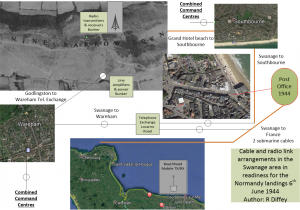The German Invasion – Operation Sealion
The invasion front between Swanage to Brighton, German embarkation point Le Havre had an invasion army of approximately 60,000 troops three divisions. The total invasion force, from the IX Armee, was a total four divisions. This would require 45 ships, 90 barges, 30 tugs and 180 E-Boats.
Swanage Invasion Preparations
The proposed invasion army for the first wave for the entire front was 90,000 troops with appropriate war equipment. The second wave consisted of 170,000 troops with equipment, 57,500 horses, 34,200 vehicles; this required 760 transport barges, 187 tugs, 2 million tons of equipment. The overall manpower total was 260,000 troops (13 divisions)
The invasion front between Swanage to Brighton, German embarkation point Le Havre had an invasion army of approximately 60,000 troops three divisions, the total invasion force, from the IX Armee, was a total four divisions. This would require 45 ships, 90 barges, 30 tugs and 180 E-Boats.
At the time, the Military intelligence stated the most likely coastal attack was between Hurst Point and Durlston Head, Swanage.
Normandy Telecommunications Link
In late 1941, the General Post Office commenced discussions with military authorities concerning communications with the proposed British invasion forces and Swanage was chosen to host two submarine cables as communication links to the D-Day invasion beaches, located in the Cherbourg area. A factor for choosing Swanage was its 150Km proximity to Cherbourg.
Technology at the time could only cater for distance of approximately 150Km, without signal amplification, any longer would require signal line amplifiers. It also required a high frequency radio link from a high point, Swanage was ideal, Godlingston Hill was a suitable height. The proposed invasion beach transmissions were to be sent by private lines to three Combined Command Centre headquarters located at Plymouth, Portsmouth and Dover. Lines to the signal centre at Southampton were included and the Dover links were allocated as a bogus invasion embarkation point to fool the enemy – which was successful in drawing the majority of German tanks to Calais in June 1944.
Arrival of the American Army
The American Army 26th Infantry Regiment – known as the “Blue Spaders”, part of the Big Red One division, arrived in Swanage on November 1943, providing a huge boost to the beleaguered moral of the local population. They had food in abundance which they willing shared with the town’s population and the town viewed them as their saviours from the possibility of Nazi tyranny. It made people more positive and less tense they thought we have this rich and powerful friend and cannot lose the war!
The troops wore battle dress most of the day during training and when off-duty a walking out uniform made of a softer cloth, with olive green tunics, collar and tie, fawn trousers, neat shoes and a mass of brass buttons. Their equipment, for example ammunition and guns, arrived in wooden boxes made of 13 cm thick wooden sections. After they were no longer needed and dis-guarded, the locals reused them as garden sheds. When they left, the Swanage population fed on dis-guarded tinned meat for weeks.
When D-Day occurred on the 6th June 1944, at Worth Matravers it was possible to see the red glow emanating from their destination on the southern horizon.
From the 1st Division D-Day journal25
It was at 19:30 or H Plus 12 hours that the 26th Regiment, a reserve regiment, disembarked onto Omaha Fox Green beach.
Due to overhead cloud and gun fire the first opportunity the reserve regiment had to view the beach was at 15:00 hours, it was littered with vehicles and equipment and enemy fire falling the length and depth of the beach. To top this formidable array of defensive beach artillery was the Maisy Battery, positioned on a 100 foot cliff on the western edge of Omaha beach, this had 155 mm guns.


